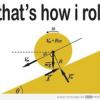
A cloaking device works by transmitting light rays around an object so that it appears as if nothing is there. The transmitted light waves, in theory, should look as if there is no background interruption.
John Howell, physics professor at the U of R, and graduate student Joseph Choi created a cloaking system with minimal distortion of surroundings. It utilizes four different lenses, 2 with one focal length and 2 with another (the U of R did a lot of research on the specific focal lengths of these lenses to prevent distortion, I'm not positive on the ratios). The lenses are arranged F1 F2 F2 F1, and the lenses are then separated so that t1=F1+F2 and t2=2F2(F1+F2)/(F1-F2) (See diagram).
The University of Rochester's cloaking device solves previous problems of cloaking in multiple dimensions. Previous cloaking devices worked successfully when the viewer was looking head on, but once their angle changed, the background was distorted, and it was immediately apparent that there was an object being cloaked.
This use of light distortion and lensing may not be the cloak of invisibility Potter fans are familiar with, but I think any physics dealing with 'invisibility' is pretty nifty!
Until next time, Fizzix Community, until next time.
- Read more...
- 0 comments
- 396 views

